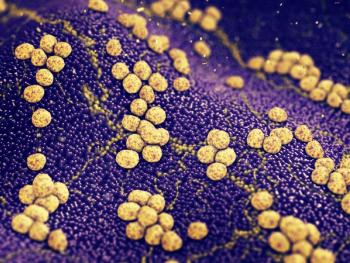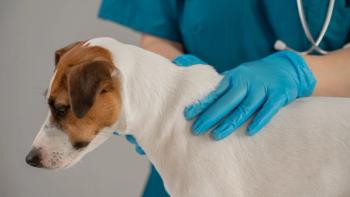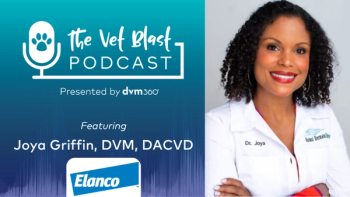
|Articles|October 1, 2011
Managing sebaceous adenitis and symmetrical lupoid onychodystrophy (Proceedings)
Author(s)Edmund J. Rosser, Jr., DVM, DACVD
A symmetrical partial alopecia and excess scaling with follicular casts. Remaining hair is dull and brittle
Advertisement
Sebaceous adenitis
- Etiology
- Unknown
- May be an immune mediated disease
- May be a genetically inherited defect – autosomal recessive trait.
- Keratinization abnormality with obstruction of sebaceous duct?
- Abnormality in sebaceous lipids?
- Clinical features ? 2 forms
- Sebaceous Adenitis with Hyperkeratosis – Long Coated Breeds
- Seen in all color variants of standard poodles (may be similar in other long?coated breeds of dogs such as Samoyeds and Akitas).
- A symmetrical partial alopecia and excess scaling with follicular casts. Remaining hair is dull and brittle.
- Affects dorsal planum of the nose, top of head, dorsal neck and trunk, tail and pinnae.
- Non?pruritic and no offensive odor
- May develop secondary bacterial folliculitis with pruritus.
- Hair may become straight and lose its “curl”.
- Granulomatous Sebaceous Adenitis – Short Coated Breeds
- Affects short?coated breeds of dogs ? Vizslas, Weimaraners
- Begins as a moth?eaten alopecia with minimal to no scaling.
- Primarily affects the trunk, head and ears.
- Non?pruritic
- Diagnosis
- Histopathology
- Initial nodular granulomatous to pyogranulomatous inflammation at the level of the sebaceous glands.
- Depending on the type, there may or may not be prominent hyperkeratosis.
- Chronic cases develop a complete loss of sebaceous glands with fibrosis, atrophy of hair follicles and in some cases complete loss of the adnexa with fibrosis.
- Treatment
- Propylene glycol ? a hygroscopic lipid solvent that penetrates the horny layer and increases water content. 50?75% propylene glycol with water?applied daily as a spray.
- Bath Oil Treatments (light mineral oil) – 50:50 mixture of bath oil and water, spray over the entire body, rub into the hair coat well, allow to soak for 1-2 hours. Remove oil by bathing with dish soap 2-3 times, and then finish with a moisturizing shampoo and conditioner/crème rinse for the final bathing. Repeat q 7 days for the first month, the q 14-30 days prn.
- EFA Supplement - Derm Caps ES - 1 capsule BID; Evening Primrose Oil (EPO) - 500 mg BID.
- Anti?seborrheic shampoos, conditioners and emollients have been of little benefit.
- Treat secondary pyoderma if present.
- Isotretinoin (Accutane®) - 1 mg/kg SID-BID.
- Acetretin (Soriatane®) - 1 mg/kg SID-BID
Advertisement
- Cyclosporine (Neoral, Gengraf, Atopica) - 5 mg/kg BID.
- Vaseline Intensive Care Lotions daily without washing.
- Allerderm Spot-On – apply daily or from 1-3 times/week prn.
- Dermoscent Essential 6 – apply once weekly prn.
- Douxo Calm Shampoo and Spray – apply 3 times weekly.
- Douxo Seborrhea Shampoo and Micro-emulsion Spray – apply twice weekly.
- Essential fatty acid dietary supplement (Derm Caps ES) – 1 capsule BID + Evening primrose oil – 500 mg BID.
- High empirical dosages of purified fish oil daily (1000 mg?) – Marshall, Williams – Adv Vet Derm, Vol 1:446, 1990.
- Vitamin A – 8,000-10,000 I.U. – SID-BID x 3 months, then up to 20,000-30,000 I.U. – BID. Needs to be esterified for stability and from a quality controlled and reliable manufacturer (DSM Nutritional Products – formerly Roche; Bio-Tech Pharmaceutical). Mark Papich – 600-800 I.U./kg SID.
- Tetracycline and Niacinamide – 10 mg/lb of each drug, not to exceed 500 mg TID of each drug.
- Doxycycline – 5-10 mg/kg SID, with or without concurrent Niacinamide.
- Prognosis
- Akitas – tends to be more severe, chronic recurrent pyoderma more of a problem, possible signs of systemic illness.
Standard Poodles – aesthetic disease, secondary pyoderma rare, difficult to regrow “normal” hair coat.
- Short Coated Breeds – occasionally “cured” by treatment.
Lupoid onychodystrophy
- Pathogenesis
- Unknown
- Suspected to be a lupus-like, immune-mediated disease
- Secondary bacterial paronychia common (esp. Staphylococcus intermedius)
- A possible “novel” reaction pattern to “common” underlying diseases
- Food Allergy
- Atopic Dermatitis
- Clinical Features
- German Shepherd dogs predisposed
- Acute onset of sloughing of one or more nails
- Nails avulse by lifting up distally from the corium, and continuing proximally to the claw fold
- Lameness associated with avulsion of each nail
- Subsequent loss of all nails may occur over several weeks to months
- Regrowth characterized by short, malformed, soft, dry, brittle nails
- Diagnosis
- Rule out potential underlying disease processes:
- CBC, Profile, U/A
- ANA, Cold Agglutinins
- Elimination diet trial testing
- Intradermal skin testing
- Macerated tissues culture of nail
- Bacterial culture and sensitivity
- Fungal culture
- Nail biopsy techniques:
- P3 amputation
- Longitudinal punch biopsy (8 mm)
- Nail trim flush to the nail fold
- Histopathology:
- Hydropic degeneration of basal cells
- Lichenoid interface dermatitis
- Treatment
- Treat underlying disease process if possible
- Hypoallergenic diets
- Allergen-specific Immunotherapy (ASIT)
- Essential fatty acid supplements - Derm Caps SID
- Vitamin E - 400-800 IU's – BID
- Tetracycline and Niacinamide - 10 mg/lb of each TID
- Doxycycline – 5-10 mg/kg SID (with or without concurrent Niacinamide)
- Biotin (Appearex®) – 2.5 mg/dog SID
- Pentoxifylline – 15-30 mg/kg TID
- Cyclosporine – 5 mg/kg SID
- Systemic antibiotics based on culture and sensitivity for secondary paronychia
- Cephalexin - 15 mg/lb BID x 2-4 months
- Prognosis
- Possible cure if underlying disease process is identified and treated
- Food Allergy – lifelong hypoallergenic diets
- Atopic Dermatitis – lifelong ASIT
- Discontinuation of therapy invariably results in relapses
- Regrown nails are usually malformed, soft, and friable
- Process of avulsing nails and lameness is halted
Newsletter
From exam room tips to practice management insights, get trusted veterinary news delivered straight to your inbox—subscribe to dvm360.
Advertisement
Advertisement
Advertisement
Trending on dvm360
1
Generic drug for canine osteoarthritis receives FDA approval
2
Preventing periodontal disease in dogs
3
Minimally invasive sterilization for canines and felines
4
FDA conditionally approves combination parasiticide for New World screwworm
5




